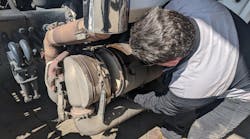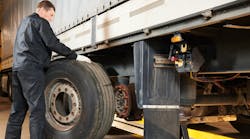In today's rapidly evolving commercial vehicle industry, an overextended pool of technicians needs quick access to everything from fault codes and diagnostics to wiring diagrams, service bulletins, and parts lists. With a little patience and a lot of free time, most anything can be found by searching online. But for technicians who would rather turn wrenches than surf websites, a subscription to some kind of information library can be a wise investment.
Gino Fontana, vice president of operations for Transervice, a provider of freight management, fleet leasing, and contract maintenance services, thinks back to when he first started working in the industry 20-plus years ago.
"We had to go to a bookshelf to page through Motor and Chilton manuals, looking for step-by-step instructions on repairs and how to connect two parts," Fontana says. "Now the first thing a technician does when a truck pulls into the bay is hook it up to a laptop, unless the problem is something very obvious like a leak. Technology is the driving piece now."
Once the diagnostic tool is connected, however, technicians need resources to diagnose the issue and decide on the next steps in the repair process.
"Today's vehicles incorporate top-level technology, such as calibrations that require specific settings, and sensors that go to even the slightest of details," says Bruno Gattamorta, vice president of sales and marketing for Cojali USA, a manufacturer of technology and diagnostic tools. "Having said that, a diagnostics tool is the way to get things done. But you still have the part of, 'What do I have to do?'
"Identifying a fault code is not enough," Gattamorta continues. "You need to know what it looks like, where it's at, what the voltage or resistance levels are, and how it is wired to the ECM (engine control module). You probably even need a step-by-step procedure on how to change a component. You could spend a lot of time searching on Google, or maybe call a friend or dealer you work with. In essence, the more you know, the less you need."
Connecting diagnostic insights to repair guidance
Time and money are two common challenges a fleet faces in obtaining all of the necessary repair information its technicians need. Looking to a resource that compiles as much of the information as possible can be the only practical solution.
In the case of Cojali, Jaltest is the company's all-makes all-models diagnostic tool. Jaltest INFO Online is the complement to that tool.
"Most of the information provided by Jaltest INFO Online is purchased from OEMs that are forced to sell due to Right to Repair," Gattamorta points out. "This allows a process of understanding and information integration. But without the thousands of users we have, it would be nearly impossible to maintain. An independent shop sometimes doesn't have access to purchase certain things. If it does, it isn't cheap. Buying it all and using it without a company that acts as an integrator is probably not a good idea."
Jaltest INFO Online provides a vast array of technical information through different modules, including component descriptions and replacement guides, wiring diagrams, fault code troubleshooting guides, and service bulletins.
"We need to remember that we are an industry of technicians, not computer masters," Gattamorta says. "If we complicate things in different platforms and work logics, we just drive everyone crazy. That's why we integrate diagnostics and technical information in one format and one platform."
When it comes to arming Transervice's technicians with the repair information they need, Fontana agrees that the first step is vehicle performance data. There are many solutions out there from OEMs, such as PACCAR Solutions and International's Diamond Logic Builder. That list gets really long, however, once a fleet identifies all of the truck brands and systems its technicians have to work on. For Transervice, the ability to service mixed fleets requires a good telematics data consolidator that delivers data on all makes and models.
"We use Noregon," Fontana relates. "There are other good products on the market and we are always looking, but Noregon has been very good. We get access to not only all of the major truck manufacturers, but also systems like Cummins engines and Eaton transmissions. Noregon is our one source for everything we need to know, including service bulletins, recalls, schematics, and so on."
NEXIQ Technologies, a provider of diagnostic and telematics products and services, has also taken steps to streamline the research process for technicians. With both Pro-Link Edge (scan tool) and eTechnician (PC-based software), vehicle history reporting has become more transparent.
"If you're a fleet, a vehicle might not be in your shop," says Tom Kotenko, company director of NEXIQ Technologies. "A vehicle may go to Detroit one day and Chicago the next. Both Pro-Link Edge and eTechnician allow a technician in one location to see exactly what took place when the vehicle was in the other location. The technician can see all of the trouble codes, as well as any notes from other technicians. This reporting is done either by the VIN or fleet unit number."
Pro-Link Edge and eTechnician each integrate with Mitchell 1's library of medium and heavy duty truck repair information. This integration provides technicians with a more thorough diagnostic and repair process in the service bay.
"As a technician obtains a trouble code, he or she can immediately go into the repair and installation procedures for that specific trouble code," Kotenko explains. "We don't want the technician to have to go out and search for this information; that is old school. We want to provide the information to them."
NEXIQ Technologies and Mitchell 1 are both part of the Snap-on family of brands. Mitchell 1 has been providing repair information to the automotive industries for roughly 100 years.
The more thorough, the better
As of late, Kotenko says NEXIQ Technologies has been watching growth in the Class 3 to Class 6 segments that are a good fit for last-mile delivery. "We've really beefed up our software in those areas," he says. "Having the ability to service mixed fleets is increasingly important, so that's where we've focused a lot of our attention."
Mitchell 1 has continued focusing much of its attention on providing a holistic repair solution to fleet technicians.
"As medium and heavy duty trucks become more complex, having access to service information related to the whole vehicle, as opposed to just bits and pieces, is vital," says Kristy LaPage, business manager for the commercial vehicle group at Mitchell 1.
As LaPage points out, different truck systems are often dependent on each other, or can be affected by one another.
"Knowing how different systems work together – and knowing how there is cause and effect with the different systems – is vital to a repair shop," LaPage says.
For instance, a hard shift in an automatic transmission could result in a faulty engine temperature sensor showing up on a scan tool. However, those things could be completely unrelated. At the same time, the transmission might be the system that throws a fault code, but the problem is an engine temperature sensor.
"There is a demand on technicians to be able to understand all of these systems, so they need access to a lot of information," LaPage says.
Sourcing repair information that provides a holistic, 360-degree view of a medium or heavy duty truck can be a challenge for fleets. There are several repair information providers out there. However, some don't cover the heavy duty segment, and others only provide the "bits and pieces" LaPage referenced earlier.
Mitchell 1's Truck Series provides a holistic view, LaPage says, covering all makes and models of Class 4 through Class 8 vehicles. Information is updated every 30 days and goes all the way back to 1990, with diagnostic information going back to around 2000.
Making information easier to access
In this day and age, LaPage says Mitchell 1's repair information is almost exclusively accessed online.
"Thank goodness for technology, because there is no way we would be able to do this without it," LaPage says. "When you think about how many books it would take to provide a 360-degree view of every make and model, it would be impractical these days."
The website that houses Mitchell 1's Truck Series repair information can be accessed via any connected computer or mobile device, though LaPage says a laptop is the most common method.
"We have wiring diagrams and photographs, [so] most technicians want the viewing experience of a computer, or at least a decent-size tablet," LaPage says.
The challenge for a fleet is to make it easy for technicians to hop on a computer.
Transervice asked its technicians to help find a solution. The result is a mobile cart that the technicians themselves designed and built. The cart is based on a common rolling cart you already see in many shops. Several modifications make it a highly efficient tool to help technicians stay "plugged in" in the service bay – without having to actually be plugged in.
"The carts have all of the adapters and connectors we need for the laptops," Fontana says. "There's a convenient flat working surface and a couple of handy drawers. Our system is designed to work off of batteries so the computers don't have to be plugged into an outlet. The carts have batteries and power inverters on them. We also went with a bigger screen that's easy to see. That way, when a technician has half of their body under the dashboard, they can look over to the cart and easily see what's on the screen. That has helped improve efficiency. Plus, since the technicians themselves actually designed this cart, we get the ultimate buy-in."
Buy-in is definitely important. So is giving credit where credit is due. LaPage credits the Mitchell 1 staff for what the company is able to provide to fleets.
"We have an amazing staff that works hard to make sure content is not only accurate, but also accessible – which is something that can never be overstated," LaPage says. "If a technician can jump on a computer and pull up some repair information, that is great. But if it takes the technician forever to find that information, that isn't so great. In fact, that's not much better than digging through books. Our team works hard to make sure our user experience is as efficient as it can be."
Mitchell 1's Truck Series continues to evolve from that standpoint. Today, there is a much more user-friendly search engine. A technician can type in a component, symptom, or fault code; any information related to the characteristic the technician typed in will show in the search results.
"Then the technician can quickly access whatever information he or she needs," LaPage says.
Truck Series wiring diagrams have also been "modernized" to make things easier for the technician. Now a technician can type in a component and be taken directly to the precise location on the diagram. Additionally, technicians never have to leave a wiring diagram to seek out repair information. The two are now integrated and interactive.
"As you are tracing a wiring diagram, you can click on a hyperlink that will open another window that provides information on a fuse or other component that might be affected," LaPage explains.
Industry advocates such as the National Automotive Service Task Force (NASTF) are also taking steps to improve their information delivery.
"We will be launching a redesigned website later this year," says Holly Wolfe, managing director of NASTF. "The site will include many improvements to the way our members access service information. Through the creation of a personal profile, users can customize the type of information they want to receive, delineated by vehicle make or areas of interest. This will allow NASTF to deliver OEM news, urgent service alerts, or any other type of industry information as soon as it's available."
NASTF is a cooperative effort among vehicle OEMs, equipment and tool makers, and service providers to ensure that technicians employed outside of the OEMs' franchise systems have the information, training, and tools necessary to properly diagnose and repair today's increasingly high-tech vehicles.
"NASTF has also partnered with Diagnostic Network to create a forum for technicians to crowdsource solutions to common issues," Wolfe continues. "Oftentimes the answer to the problem is out there – it's only a question of knowing where to look."
Repair information is crucial to retaining an efficient operation and optimized uptime. There are many sources of repair information available today, so it is important to find out which ones work best for your fleet.







